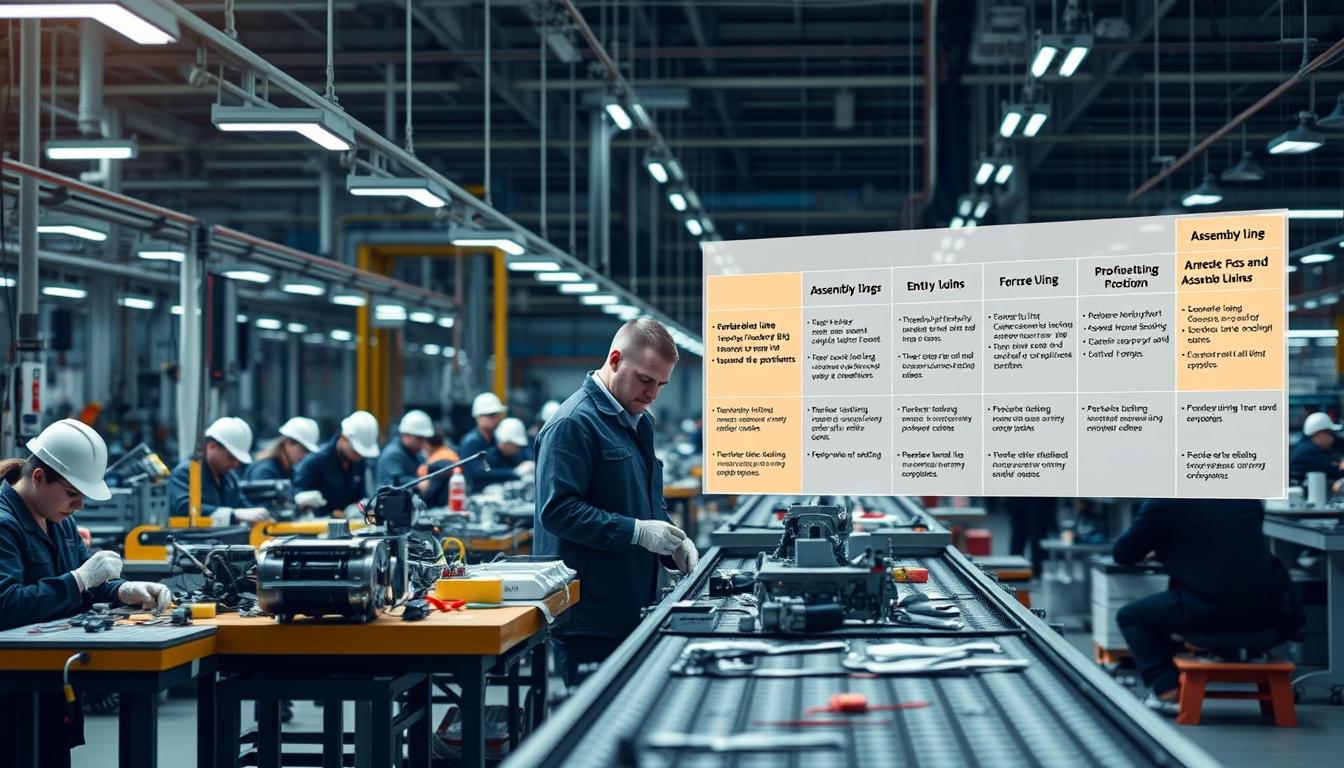Did you know 73% of manufacturing hiring managers now prioritize tech-savvy candidates, even for entry-level roles? As factories evolve with smart sensors and collaborative robots, landing production positions requires fresh strategies. The sector offers stable opportunities – with proven resume templates and smart preparation, you can stand out in this shifting landscape.
Modern manufacturing demands more than physical stamina. Employers seek workers who adapt quickly to new tools while maintaining strict quality standards. Whether you’re entering the workforce or transitioning from retail/warehouse roles, transferable skills like equipment operation and process optimization become your secret weapon.
Platforms like RoboApply simplify the job hunt with automated job-matching tools tailored for industrial careers. Their systems analyze 300+ data points to highlight your most relevant qualifications, from forklift certifications to team leadership experience.
Key Takeaways
- Automation creates 15% more tech-integrated roles by 2025
- OSHA certifications increase interview chances by 40%
- AI tools like RoboApply reduce application time by 65%
- Cross-training in multiple machines boosts earning potential
- Digital workflow knowledge is now essential for 89% of employers
Understanding the Role of an Assembly Line Worker
Manufacturing floors thrive on precision. Every shift brings new challenges requiring sharp focus and adaptability. Let’s break down what this position truly involves beyond the basics.
Core Tasks in Daily Operations
Your primary duty involves managing multiple stations simultaneously. You’ll operate pneumatic tools to fasten components, monitor conveyor speeds, and conduct spot checks using digital gauges. Precision matters – a 0.5mm variance could scrap entire batches.
Quality assurance forms 30% of your shift. You’ll compare finished products against spec sheets, document deviations, and initiate rework procedures. Top performers catch 98% of defects before items reach packaging.
Non-Negotiable Skills for Candidates
Physical endurance meets technical aptitude here. Employers verify candidates can:
- Maintain manual dexterity through 8-hour shifts
- Interpret CAD-based assembly diagrams
- Collaborate with maintenance teams on equipment calibration
Modern facilities use interactive troubleshooting guides embedded in workstations. Familiarity with touchscreen interfaces gives you an edge over traditional applicants. Those updating their machine operator credentials see 22% faster career progression.
Team coordination separates adequate workers from exceptional ones. You’ll develop hand signals for noisy environments and master shift-change briefings that keep production flowing smoothly.
Essential Resume Tips for Assembly Line Jobs
Your resume is the first impression you make on hiring managers—make it count. Modern production facilities use applicant tracking systems (ATS) that scan for specific keywords and metrics. 83% of qualified candidates get rejected due to poor formatting alone.

Smart Tools for Strong Applications
RoboApply’s AI resume builder transforms generic submissions into targeted documents. Their system auto-generates achievement statements like:
- Boosted line efficiency by 18% through workstation reorganization
- Trained 12 team members on CNC machine safety protocols
- Maintained 100% compliance across 200+ daily quality checks
Review assembly line resume examples to identify patterns successful candidates use. The platform’s ATS optimizer ensures your document matches job descriptions while avoiding keyword stuffing.
Transferable skills from fields like construction or logistics gain new relevance when framed correctly. RoboApply’s grammar checker helps rephrase statements like “Managed warehouse inventory” to “Optimized material flow for 35+ production stations daily.”
Safety certifications and equipment specialties belong in a dedicated technical skills section. For specialized roles, adapt templates from construction CV guides to highlight machinery expertise.
Crafting a Winning Cover Letter for Assembly Line Workers
Your cover letter is the golden ticket to showcase what resume bullet points can’t. Start with headlines that command attention: “Quality-Focused Production Specialist with 500+ Hours of Precision Assembly Experience” outperforms generic titles. This approach immediately aligns your strengths with employer needs.
Personalization matters. Research hiring managers’ names through company websites or LinkedIn. A simple “Dear Ms. Rodriguez” feels more intentional than “To Whom It May Concern.” Pair this with opening lines that blend your experience with measurable results:
“In my previous role, I reduced component waste by 22% through improved quality checks – a skill directly applicable to your team’s efficiency goals.”
Structure body paragraphs to mirror the job description’s priorities. If the role emphasizes machinery operation, highlight specific equipment certifications and their impact on production timelines. RoboApply’s AI builder transforms vague statements into targeted claims like “Optimized conveyor belt workflows, cutting hourly downtime by 14%.”
Close with enthusiasm and clear next steps: “I’d welcome the opportunity to discuss how my defect reduction strategies can benefit your assembly line operations.” Tools like RoboApply’s template library help maintain professional formatting while ensuring ATS compatibility.
Remember: Quantify everything. Instead of “Handled quality control,” write “Performed 150+ daily inspections with 99.8% accuracy rate.” These specifics prove your value faster than any generic claim.
Building Your Skills: From Manual Dexterity to Quality Control
Success in manufacturing hinges on mastering both physical precision and technical know-how. Start by practicing hand-eye coordination drills – sorting mixed nuts or assembling mock components builds the manual dexterity needed for intricate tasks. These exercises mirror real-world scenarios like installing micro-fasteners or aligning sensitive parts.

Technical Skills and Practical Examples
Quality control expertise separates adequate workers from exceptional ones. Train your eye to spot hairline cracks or misaligned seams using sample products. Many facilities use digital inspection checklists – practice documenting defects with timestamps and severity ratings.
Build stamina through interval training: alternate 45 minutes of focused activity with 5-minute stretching breaks. Proper footwear and anti-fatigue mats help maintain energy during 10-hour shifts. For equipment mastery, study machinist manuals covering torque specifications and emergency stop protocols.
- Use tweezers to transfer 100+ tiny screws between containers daily
- Analyze rejected units to identify recurring production issues
- Shadow experienced technicians during machine calibration routines
Enhance attention to detail with timed component inspections. Track progress using performance metrics similar to those in professional resumes. Record your speed and accuracy rates weekly to demonstrate measurable improvement.
Master workflow optimization by diagramming mock assembly processes. Identify bottlenecks like delayed part deliveries or inefficient tool placement. These problem-solving drills prepare you for real-time adjustments on active production lines.
How to Land a Assembly Line Worker Job in 2025
The final stretch of your job search demands strategic action. With production roles becoming more competitive, differentiation lies in showcasing adaptability and technical fluency. Employers value candidates who balance speed with precision while collaborating seamlessly across teams.
Strategies for Standing Out in a Competitive Market
Master industry-specific terminology during interviews – terms like “cycle time optimization” or “error-proofing systems” demonstrate deeper understanding. Prepare stories of resolving line stoppages or improving workflow efficiency. Review common assembly line interview questions to craft compelling responses.
Cross-train in adjacent areas like quality assurance or inventory management. This versatility makes you indispensable during shift changes or peak periods. Document achievements numerically: “Reduced component waste by 17% through improved inspection processes.”
Utilizing RoboApply Tools to Optimize Your Application
Leverage AI-powered platforms to streamline your search. RoboApply’s resume scanner identifies gaps in your skills section, suggesting relevant certifications like OSHA 30-hour training. Their interview simulator provides instant feedback on responses to scenario-based questions.
Upgrade your materials using professional resume templates tailored for production roles. The system auto-matches your experience with job requirements, increasing visibility in applicant tracking systems. For career changers, their skills translator rephrases retail or service experience into manufacturing-relevant competencies.
Stay persistent. Follow up applications with brief emails highlighting one specific qualification from the job description. With the right tools and preparation, you’ll position yourself as the solution employers need.
FAQ
What technical skills are most important for assembly line roles in 2025?
Employers prioritize hands-on abilities like machinery operation, tool calibration, and quality inspection. You’ll need manual dexterity for precise part assembly and basic troubleshooting skills to address equipment issues quickly. Familiarity with digital production tracking systems is increasingly valuable.
How can I show quality control experience on my resume?
Highlight specific tasks like defect identification, product testing, or using measurement tools like calipers. Quantify results where possible: “Reduced production errors by 18% through systematic quality checks.” Use RoboApply’s AI builder to match these details to job descriptions automatically.
What physical requirements should I prepare for?
Expect standing for 8+ hours, lifting 25-50 pounds regularly, and repetitive motions. Build endurance through strength training and practice using hand tools for extended periods. Many employers test grip strength and mobility during hiring assessments.
How does RoboApply help with assembly line job applications?
The platform scans job posts to optimize your resume keywords like “production workflows” or “batch processing.” Its cover letter generator tailors content to emphasize safety compliance and team collaboration – critical traits for manufacturing roles.
What certifications boost manufacturing job applications?
OSHA safety training, Lean Six Sigma White Belt, and forklift operation licenses make you stand out. Many community colleges offer affordable 4-8 week programs in automated systems maintenance or ISO 9001 quality standards.
How do I explain attention to detail in interviews?
Use specific examples: “Caught 12+ misaligned components per shift using visual inspection protocols.” Describe your process for documenting defects or escalating machinery issues without slowing production timelines.


















